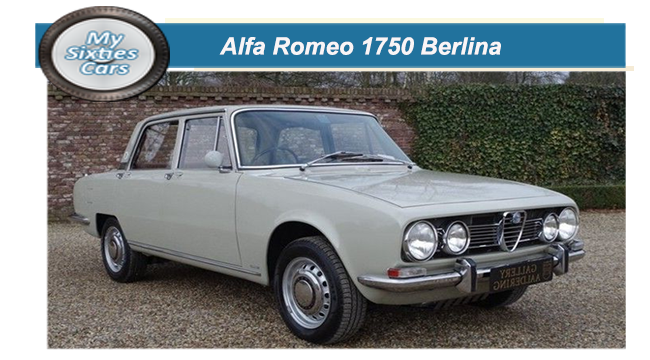
Late in 1967 Alfa Romeo introduced what became known as the 1750 series.
The series comprised the GT Veloce Coupe, Spider open top and Berlina sedan.
F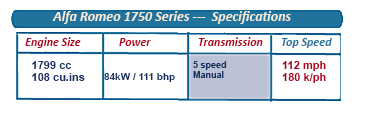 or the first time in their history, Alfa Romeo used the same size and type of engine to power all three versions of what were essentially different models.
or the first time in their history, Alfa Romeo used the same size and type of engine to power all three versions of what were essentially different models.
Sensing that the demand for a more powerful sports saloon was on the rise, early in 1968 Alfa Romeo introduced the 1750 Berlina to complete the saloon range above the Giulia 1300cc and 1600 cc models.
The 1750 Berlina, (Italian for a sedan (or saloon car)) was developed to be Alfa Romeo’s executive model 4 door saloon car to meet demand for this niche, which the company was aware of, although unsure of its extent.
T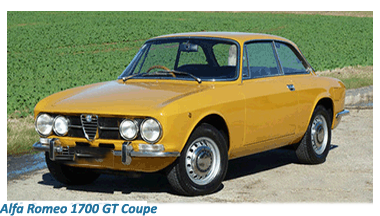 he 4-door “notchback” Alfa Romeo Berlina made its public debut at the Brussels Motor Show sharing the stand with two other new arrivals, the Spider Veloce and 1750 GT Veloce coupé
he 4-door “notchback” Alfa Romeo Berlina made its public debut at the Brussels Motor Show sharing the stand with two other new arrivals, the Spider Veloce and 1750 GT Veloce coupé
The Berlina1750 bore only scant comparison to the Giulia saloons, with revamped bodywork, a considerably longer wheelbase, and a more powerful engine.
Despite that, the 1750s shared a number of standard parts, not only with the Giulia saloons but also with other Alfa Romeo models of the time. ![]()
Once again the task of revising the 1750 body shells was handed to Giorgetto Giugiaro of the Turin design studio Bertone who had developed a very close working relationship with Alfa Romeo during the Sixties,
G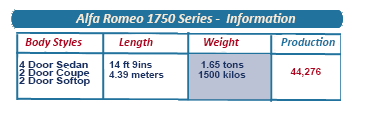 iugiaro did his usual immaculate job with the 1750 series retaining the character so well captured in the Giulia series while ironing out any possible design flaws.
iugiaro did his usual immaculate job with the 1750 series retaining the character so well captured in the Giulia series while ironing out any possible design flaws.
The Alfa Romeo 1750 was powered by a 1779 cc twin-carb engine capable of generating 116 bhp backed up by two twin side draught carburettors, matched with a five-speed manual gearbox.
A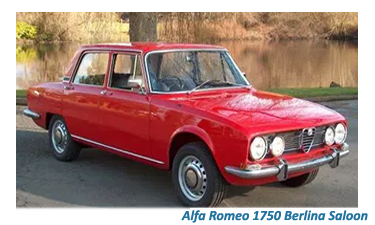 ll models were fitted with a hydraulic clutch mechanism while braking was taken care of through a twin circuit design combining servo and disc brakes.
ll models were fitted with a hydraulic clutch mechanism while braking was taken care of through a twin circuit design combining servo and disc brakes.
Towards the end of the 1750’s production, Alfa Romeo began to provide the option of fitting a three-speed automatic gearbox, an advance that proved to be less successful than anticipated.
T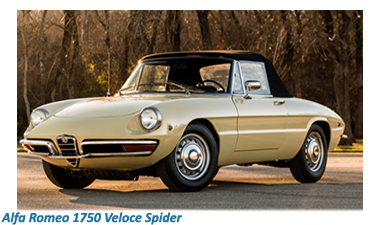 he design team at Alfa Romeo discovered too late that gearbox was not compatible with the four-cylinder engine, making for cumbersome gear changes having a negative effect on both acceleration and fuel economy.
he design team at Alfa Romeo discovered too late that gearbox was not compatible with the four-cylinder engine, making for cumbersome gear changes having a negative effect on both acceleration and fuel economy.
The Alfa Romeo 1750 Berlina remained in production for just three years between 1968 and 1971, during which time just over 100,000 models were sold, a respectable figure for a car in its particular niche
In 1971 the 1750 Berlina was superseded in the larger engine saloon class by the Alfa Romeo Alfetta.






